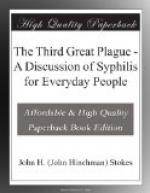The efficiency of salvarsan in the cure of syphilis in the early stages is due, first, to the large amount of it that can be introduced into the body without killing the patient, and second, to the promptness with which it gets to the source of trouble. In the old days, while we were laboriously getting enough mercury into the patient to help him to stop the invading infection, the germs marched on into his blood and through his body. With salvarsan, the first dose, given into the blood, reaches the germs forthwith and destroys them. There is enough of it and to spare. Twenty-four hours later scarcely a living germ remains. The few stragglers who escape the fate of the main army are picked up by subsequent doses of salvarsan and mercury, and a cure is assured. There is all the difference between stopping a charge with a machine gun and stopping it with a single-shot rifle, in the relative effectiveness of salvarsan and mercury at the beginning of a syphilitic infection.
In syphilis affecting the central nervous system, salvarsan, modified in various ways, may be injected into the spinal canal in an effort to reach the trouble more directly. The method, which is known as intradural therapy, has had considerable vogue, but a growing experience with it seems to indicate that it has less value than was supposed, and is a last resort more often than anything else. It involves some risk, and is no substitute for efficient treatment by the more familiar methods. If necessary, a patient can have the benefit of both.
The luetin test was devised by Noguchi for the presence of syphilis, and is performed by injecting into the skin an emulsion of dead germs. A pustule forms if the test is positive. It is of practical value only in late syphilis, and a negative test is no proof of the absence of the disease. Positive tests are sometimes obtained when syphilis is not present. For these reasons the test is not as valuable as was at first thought.
Chapter IX
The Cure of Syphilis
There are few things about our situation with regard to syphilis that deserve more urgent attention than questions connected with the cure of the disease, and few things in which it is harder to get the necessary cooeperation. On the one hand, syphilis is one of the most curable of diseases, and on the other, it is one of the most incurable. At the one extreme we have the situation in our own hands, at our own terms—at the other, we have a record of disappointing failure. As matters stand now, we do not cure syphilis. We simply cloak it, gloss it over, keep it under the surface. Nobody knows how much syphilis is cured, partly because nobody knows how much syphilis there really is, and partly because it is almost an axiom that few, except persons of high intelligence and sufficient means, stick to treatment until they can be discharged as cured. Take into consideration, too, the fact that the older methods of treating syphilis were scarcely equal to the task of curing the disease, and it is easy to see why the idea has arisen, even among physicians, that once a syphilitic means always a syphilitic, and that the disease is incurable.




